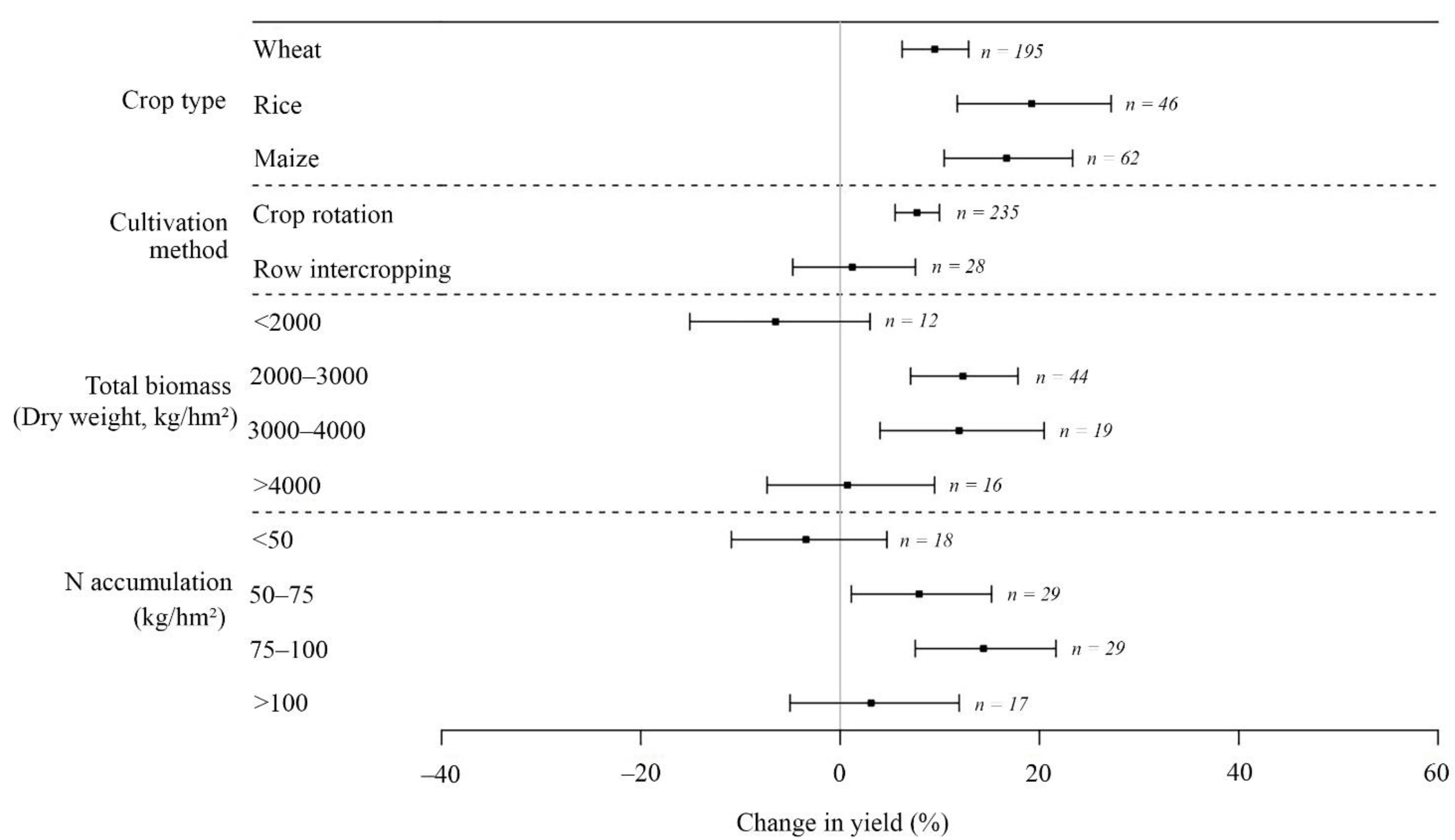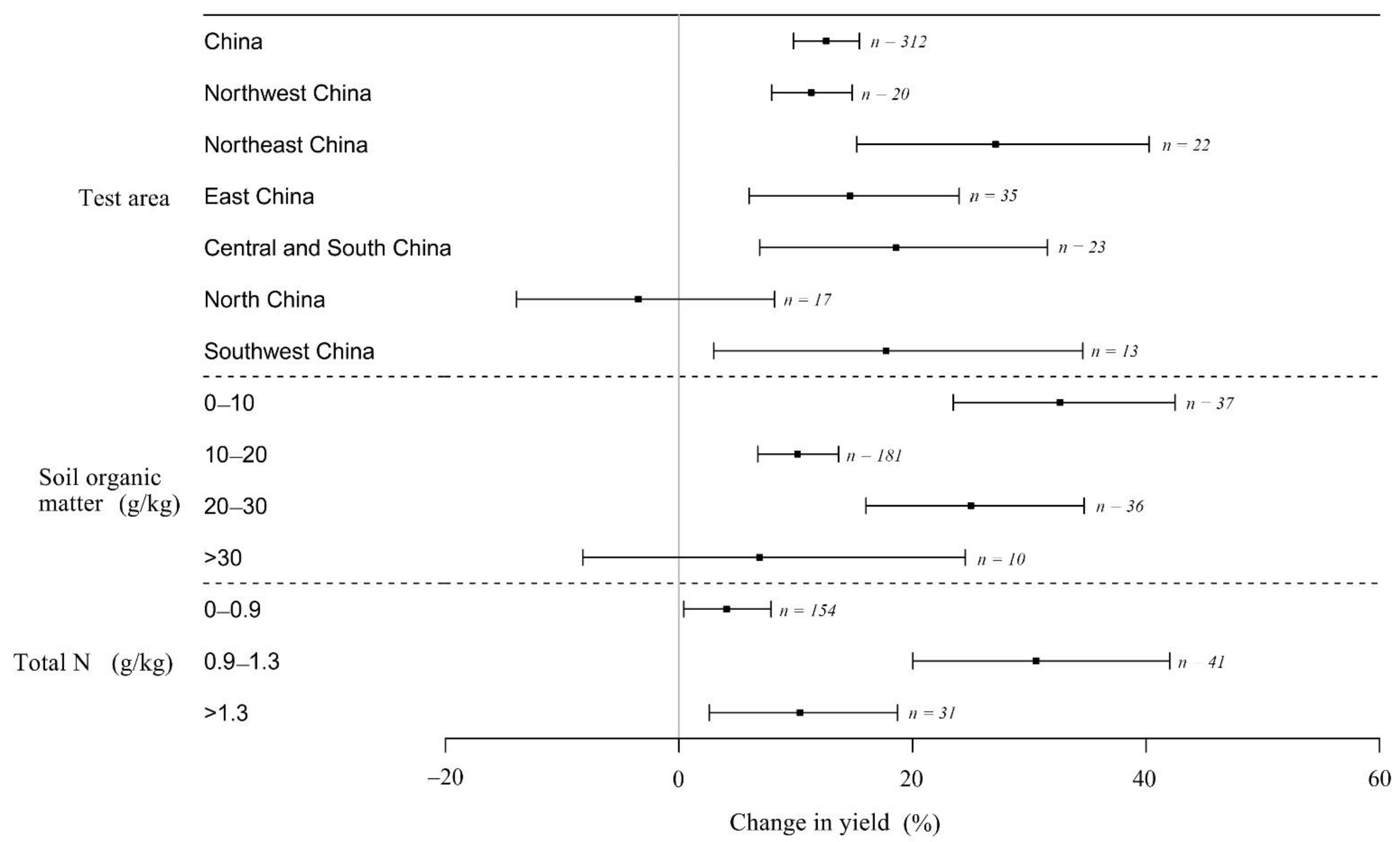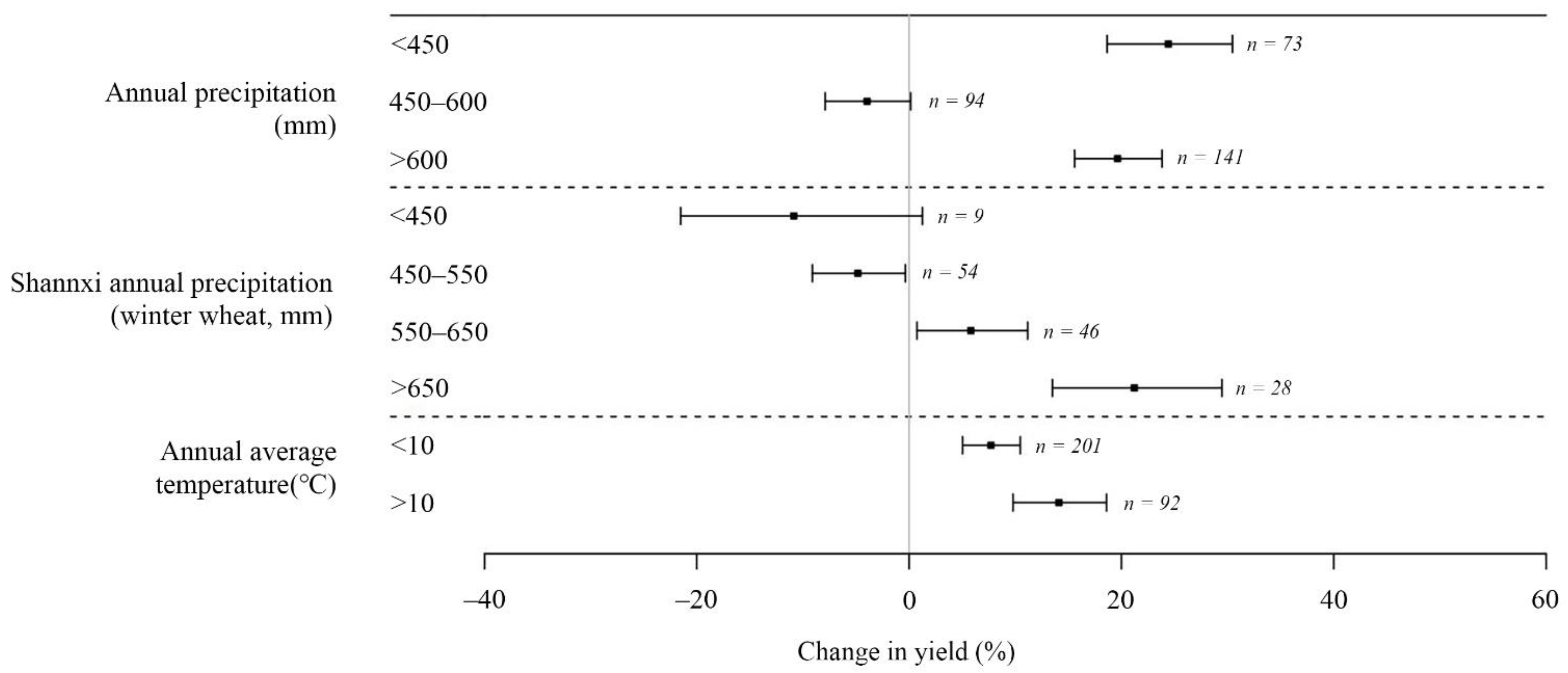Effect of Legume Green Manure on Yield Increases of Three Major Crops in China: A Meta-Analysis
Abstract
:1. Introduction
2. Materials and Methods
2.1. Data Search and Collection
- (1)
- The field experiments were conducted in China.
- (2)
- The experimental data were collected from field trials of wheat, maize, and rice cultivation systems.
- (3)
- The field trial designs had a control group with no LGM and a trial group planted with LGM, with other field management practices being consistent.
- (4)
- The data selected had information of trial replicates and mean yield for each trial treatment.
- (5)
- Data from the same experiment appearing in different papers were included only once.
2.2. Statistical Analysis
3. Results
3.1. Effects of Legume Green Manure on Grain Crop Yield
3.2. Effects of Legume Green Manure on Crop Yield in Different Regions and under Different Soil Organic Matter Levels
3.3. Effects of Legume Green Manure on Grain Crop Yield under Different Climatic Conditions
4. Discussion
4.1. Effects of Different Planting Practices and Legume Green Manure Amount Returned to the Field on Grain Crop Yield
4.2. Effects of Legume Green Manure on Grain Crop Yield under Different Environments and SOM Levels
5. Conclusions
Supplementary Materials
Author Contributions
Funding
Institutional Review Board Statement
Informed Consent Statement
Data Availability Statement
Conflicts of Interest
References
- Ibarrola-Rivas, M.J.; Granados-Ramirez, R.; Nonhebel, S. Is the available cropland and water enough for food demand? A global perspective of the Land-Water-Food nexus. Adv. Water Resour. 2017, 110, 476–483. [Google Scholar] [CrossRef]
- Chhipa, H. Nanofertilizers and nanopesticides for agriculture. Environ. Chem. Lett. 2017, 15, 15–22. [Google Scholar] [CrossRef]
- Ren, F.L.; Sun, N.; Xu, M.; Zhang, X.B.; Wu, L.H.; Xu, M.G. Changes in soil microbialbiomass with manure application in cropping systems: A meta-analysis. Soil Tillage Res. 2019, 194, 11. [Google Scholar] [CrossRef] [Green Version]
- Zhang, D.B. The Effect and Mechanism of Planting Leguminous Green Manure in the Loess Plateau to Coordinate Soil Moisture and Nitrogen Supply. Ph.D. Dissertation, Northwest A&F University, Xianyang, China, May 2016. [Google Scholar]
- Cao, W.D.; Huang, H.X. Ideas on restoration and development of green manures in China. Soil Fert. Sci. 2009, 4, 1–3. [Google Scholar]
- Yao, Z.Y.; Zhang, D.B.; Liu, N.; Yao, P.W.; Zhao, N.; Li, Y.Y.; Zhang, S.Q.; Zhai, B.N.; Huang, D.L.; Wang, Z.H.; et al. Dynamics and sequestration potential of soil organic carbon and total nitrogen stocks of leguminous green manure-based cropping systems on the Loess Plateau of China. Soil Tillage Res. 2019, 191, 108–116. [Google Scholar] [CrossRef]
- Xie, Z.J.; Zhou, C.H.; Shah, F.; Iqbal, A.; Ni, G. Author Correction: The role of Chinese Milk Vetch as cover crop in complex soil nitrogen dynamics in rice rotation system of South China. Sci. Rep. 2019, 9, 5789. [Google Scholar] [CrossRef] [Green Version]
- Yan, Z.L.; Fang, Y.; Chen, J.C.; Wang, F.; He, C.M.; Lin, X.J. Effect of turning over Chinese milk vetch (Astragalus sinicus L.) on soil nutrients and microbial properties in paddy fields. J. Plant Nutr. Fertil. 2014, 20, 1151–1160. [Google Scholar]
- Chen, L.Y.; Wang, Z.B.; Hu, L.P. Effects of Interplanting Six Leguminous Green Manure Plants in Apple Orchard on Soil Carbon and Nitrogen Characteristics. Acta Agrestia Sin. 2021, 29, 671–676. [Google Scholar]
- Liu, Y.B.; Hang, J.X.; Gao, J.Q. Effects of dryland vineyard cover cropping of hybrid oilseed rape on soil enzymes and nutrients. Jiangsu Agric. Sci. 2021, 49, 221–225. [Google Scholar]
- Gao, S.J.; Zhang, R.G.; Cao, W.D.; Fan, Y.Y.; Gao, J.S.; Huang, J. Long-term rice-rice-green manure rotation changing the microbial communities in typical red paddy soil in south China. J. Integr. Agric. 2015, 14, 2512–2520. [Google Scholar] [CrossRef]
- Astier, M.; Maass, J.M.; Etchevers-Barra, J.D.; PeA, J.J.; González, F.D.L. Short-term green manure and tillage management effects on maize yield and soil quality in an andisol. Soil Tillage Res. 2006, 88, 153–159. [Google Scholar] [CrossRef]
- Cordoa, E.M.; Chirinda, N.; Li, F.; Olesen, J.E. Contributions from carbon and nitrogen in roots to closing the yield gap between conventional and organic cropping systems. Soil Use Manag. 2018, 34, 335–342. [Google Scholar] [CrossRef]
- Toom, M.; Tamm, S.; Talgre, L.; Tamm, I.; Tamm, L.; Narits, L.; Hiiesalu, I.; Me, A.; Lauringson, E. The Effect of Cover Crops on the Yield of Spring Barley in Estonia. Agriculture 2019, 9, 172. [Google Scholar] [CrossRef] [Green Version]
- Li, K.Y.; Wang, Z.H.; Zhao, H.B.; Zhao, N.; Gao, Y.J.; Lyons, G. Effect of wheat rotation with legume green manure and nitrogen application on wheat yield and seed nutrients in the dryland of Loess Plateau. Agric. Res. Arid Areas 2011, 29, 8. [Google Scholar]
- Wang, G.C.; Zhang, S.M.; Hu, F.L.; Yin, W.; Fan, Z.L.; Fan, H.; Yu, A.Z.; Zhao, C.; Chai, Q. Response of grain yield and nitrogen utilization efficiency of spring wheat to green manure incorporation amount in oasis irrigation district. J. Plant Nutr. Fertil. 2021, 27, 1164–1172. [Google Scholar]
- Zhang, S.M.; Hu, F.L.; Yin, W.; Fan, Z.L.; Chai, Q. Preliminary investigation on the substitution of green manure for chemical N fertilizer and yield increase potential of spring wheat in Hexi irrigation area. Soils Fertil. Sci. China 2021, 2, 256–261. [Google Scholar]
- Zhao, A.Q.; Wei, X.J.; Zhu, M. Meta analysis on impact of plastic film on potato yield in China. Trans. Chin. Soc. Agric. Eng. 2015, 31, 1–7. [Google Scholar]
- Liu, X.H. Exploration of some regular problems of agriculture in semi-arid regions of northwest China. Agric. Res. Arid. Areas 2000, 18, 1–8. [Google Scholar]
- Yang, J.H.; Luo, Y.L.; Chen, J.; Jin, M.; Wang, Z.L.; Li, Y. Effects of Main Food Yield Under Straw Return in China: A Meta-Analysis. Sci. Agric. Sin. 2020, 53, 4415–4429. [Google Scholar]
- Ma, D.; Yin, L.; Ju, W.; Li, X.; Wang, S. Meta-analysis of green manure effects on soil properties and crop yield in northern China. Field Crops Res. 2021, 266, 108–146. [Google Scholar] [CrossRef]
- Rahaman, M.A.; Zhan, X.Y.; Zhang, Q.W.; Li, S.Q.; Lv, S.M.; Long, Y.T.; Zeng, H.L. Ammonia Volatilization Reduced by Combined Application of Biogas Slurry and Chemical Fertilizer in Maize–Wheat Rotation System in North China Plain. Sustainability 2020, 12, 4400. [Google Scholar] [CrossRef]
- Zhang, S.H.; Wang, J.; Rajan, G.; Xing, W.C.; Hu, Y.M.; Zhang, N.N. Moisture and yield effects of green manure fill planting in loess plateau: Meta-analysis. Chin. J. Eco-Agric. 2021, 29, 1879–1892. [Google Scholar]
- Chu, X.G.; Shen, Q.R.; Li, Y.L.; Zhang, J.; Wang, S.Q. Researches on Bi-directional N transfer between the intercropping system of groundnut with rice cultivated in aerobic soil using 15N foliar labelling method. Acta Ecol. Sin. 2004, 24, 278–284. [Google Scholar]
- Du, H.C.; Zheng, H.M.; Zhou, J.; Cao, H.; Shen, B.; Lou, W.J.; Zhong, Z.T. Effect of nitrogen transfer on growth of wheat in milketch-wheat mixed cropping after inoculation of rhizobium. Acta Pedol. Sin. 2006, 43, 1043–1046. [Google Scholar]
- Guo, C.J.; Li, B.X.; Wang, B.; Li, Y.M.; Xiao, K. Physiological Mechanisms of Absorption and Use of Phosphorus with High Efficiency in Wheat Cultivars. Acta Agron. Sin. 2006, 32, 827–832. [Google Scholar]
- Vandermeer, J.H. The Ecology of Intercropping; Cambridge University Press: Cambridge, UK, 1989; pp. 324–325. [Google Scholar]
- Lv, P.; Zhang, J.W.; Liu, W.; Yang, J.S.; Su, K.; Liu, P.; Dong, S.T.; Li, D.H. Effects of nitrogen application on yield and nitrogen use efficiency of summer maize under super-high yield conditions. J. Plant Nutr. Fertil. 2011, 17, 852–860. [Google Scholar]
- He, G.; Wang, Z.H.; Li, F.C.; Dai, J.; Li, Q.; Xue, C.; Cao, H.B.; Wang, S.; Liu, H. Nitrogen, Phosphorus and Potassium Requirement and Their Physiological Efficiency for Winter Wheat Affected by Soil Surface Managements in Dryland. Sci. Agric. Sin. 2016, 49, 1657–1671. [Google Scholar]
- Laura, Y.; Osvaldo, E.S.; Amy, T.A. Differential controls of water input on litter decomposition and nitrogen dynamics in the Patagonian steppe. Ecosystems 2006, 9, 128–141. [Google Scholar]
- Setia, R.; Marschner, P. Carbon mineralization in saline soils as affected by residue composition and water potential. Biol. Fertil. Soils 2013, 49, 71–77. [Google Scholar] [CrossRef]
- Yao, Z.; Wang, Z.; Li, J.; Bedoussac, L.; Zhang, S.; Li, Y.; Cao, W.; Zhai, B.; Wang, Z.; Gao, Y. Screen for sustainable cropping systems in the rain-fed area on the Loess Plateau of China. Soil Tillage Res. 2018, 176, 26–35. [Google Scholar] [CrossRef]
- Zhang, S.L.; Lovdah, L.; Grip, H.; Tong, Y.N. Effects of mulching and catch cropping on soil temperature, soil moisture and wheat yield on the Loess Plateau of China. Soil Tillage Res. 2009, 102, 78–86. [Google Scholar] [CrossRef]
- Yang, N.; Wang, Z.H.; Gao, Y.J.; Zhao, H.B.; Li, K.Y.; Li, F.C.; Malhi, S. Effects of planting soybean in summer fallow on wheat grain yield, total N and Zn in grain and available N and Zn in soil on the Loess Plateau of China. Eur. J. Agron. 2014, 58, 63–72. [Google Scholar] [CrossRef]
- Unger, P.W.; Vigil, M.F. Cover crop effects on soil water relationships. Soil Water Cons. 1998, 53, 200–207. [Google Scholar]
- Li, Z.Q.; Wang, J.H.; Zhang, X. A review on the research of decomposition and nutrients release of green manure. Soils Fertil. Sci. China 2017, 240, 8–16. [Google Scholar]
- Magid, J.; Henriksen, O.; Thorup-Kristensen, K.; Mueller, T. Disproportionately high n-mineralisation rates from green manures at low temperatures–implications for modeling and management in cool temperate agro-ecosystems. Plant Soil 2001, 228, 73–82. [Google Scholar] [CrossRef]
- Wang, J.; BO, J.J.; Fu, X. Research progress in cover cropping and its feasibility in the dryland farming systems on the Loess Plateau. Acta Ecol. Sin. 2018, 38, 5244–5254. [Google Scholar]
- Poeplau, C.; Don, A. Carbon sequestration in agricultural soils via cultivation of cover crops–A meta-analysis. Agric. Ecosyst. Environ. 2015, 200, 33–41. [Google Scholar] [CrossRef]
- Villamil, M.B.; Bollero, G.A.; Darmody, R.G.; Simmons, F.W.; Bullock, D.G. No-till corn/soybean systems including winter cover crops. Soil Sci. Soc. Am. J. 2006, 70, 1936–1944. [Google Scholar] [CrossRef]
- Barker, J.B.; Heeren, D.M.; Koehler-Cole, K.; Shapiro, C.A.; Blanco-Canqui, H.; Elmore, R.W.; Proctor, C.A.; Irmak, S.; Francis, C.A.; Shaver, T.M. Cover Crops have Negligible Impact on Soil Water in Nebraska Maize–Soybean Rotation. Agron. J. 2018, 110, 1718–1730. [Google Scholar] [CrossRef] [Green Version]
- Duan, Y.Z.; Kang, F.R. Influences of Different Mulching Treatments on Soil Temperature, Water Content, and Water Use Efficiency of Dryland Planted with Potato. Bull. Soil Water Conserv. 2014, 34, 55–59,66. [Google Scholar]
- Lu, C.; Zhang, A. Land use transformation and its eco-environment effects in Northeast China. J. China Agric. Univ. 2020, 25, 123–133. [Google Scholar]
- Gao, J.Q.; Yang, X.G.; Dong, Z.Y.; Li, K.N. Precipitation resource changed characteristics in arid humid regions in Northern China with climate changes. Trans. Chin. Soc. Agric. Eng. 2015, 31, 99–110. [Google Scholar]
- Ren, Z.G.; Zhang, M.J.; Wang, S.J.; Zhu, X.F.; Dong, L.; Qiang, F. Changes in precipitation extremes in South China during 1961–2011. Acta Geogr. Sin. 2014, 69, 640–649. [Google Scholar]
- Cookson, W.R.; Cornforth, I.S.; Rowarth, J.S. Winter soil temperature (2–15 °C) effects on nitrogen transformations in clover green manure amended or unamended soils; a laboratory and field study. Soil Biol. Biochem. 2002, 34, 1401–1415. [Google Scholar] [CrossRef]
- Agehara, S.; Warncke, D.D. Soil moisture and temperature effects on nitrogen release from organic nitrogen sources. Soil Sci. Soc. Am. J. 2005, 69, 1844–1855. [Google Scholar] [CrossRef] [Green Version]
- Van Schöll, L.; Van Dam, A.M.; Leffelaar, P.A. Mineralisation of nitrogen from an incorporated catch crop at low temperatures: Experiment and simulation. Plant Soil 1997, 188, 211–219. [Google Scholar] [CrossRef]
- Wang, S.Q.; Zhou, C.H.; Li, K.R.; Zhou, S.L.; Huang, F.H. Analysis on spatial distribution characteristics of soil organic carbon reservoir in China. Acta Geogr. Sin. 2000, 55, 533–544. [Google Scholar]




| Factor | Classification Subgroup | Between Group Heterogeneity | |
|---|---|---|---|
| Qm | Pm | ||
| Crop type | Wheat | 8.10 | 0.0175 |
| Corn | |||
| Rice | |||
| Planting method | Crop rotation | 3.93 | 0.0473 |
| Row intercropping | |||
| Total biomass | <2000 | 17.58 | 0.0005 |
| (Dry weight, kg/hm2) | 2000–3000 | ||
| 3000–4000 | |||
| >4000 | |||
| N accumulation | <50 | 13.02 | 0.0046 |
| (kg/hm2) | 50–75 | ||
| 75–100 | |||
| >100 | |||
| Test area | China | 17.12 | 0.0089 |
| Northwest China | |||
| Northeast China | |||
| East China | |||
| Central and South China | |||
| North China | |||
| Southwest China | |||
| Soil taxonomy | Incepitsols | 0.00 | 0.9999 |
| (ST, 1999) | Mollisols | ||
| Alfisols | |||
| Ultisols | |||
| Soil organic matter | 0-10 | 28.75 | 0.0000 |
| (g/kg) | 10–20 | ||
| 20–30 | |||
| 30 | |||
| Soil total N | 0–0.9 | 25.65 | 0.0000 |
| (g/kg) | 0.9–1.3 | ||
| >1.3 | |||
| Annual precipitation | ≤450 | 86.51 | 0.0000 |
| (mm) | 450~600 | ||
| ≥600 | |||
| Annual average temperature | ≤10 | 6.13 | 0.0133 |
| (°C) | ≥10 | ||
Publisher’s Note: MDPI stays neutral with regard to jurisdictional claims in published maps and institutional affiliations. |
© 2022 by the authors. Licensee MDPI, Basel, Switzerland. This article is an open access article distributed under the terms and conditions of the Creative Commons Attribution (CC BY) license (https://creativecommons.org/licenses/by/4.0/).
Share and Cite
Liang, K.; Wang, X.; Du, Y.; Li, G.; Wei, Y.; Liu, Y.; Li, Z.; Wei, X. Effect of Legume Green Manure on Yield Increases of Three Major Crops in China: A Meta-Analysis. Agronomy 2022, 12, 1753. https://doi.org/10.3390/agronomy12081753
Liang K, Wang X, Du Y, Li G, Wei Y, Liu Y, Li Z, Wei X. Effect of Legume Green Manure on Yield Increases of Three Major Crops in China: A Meta-Analysis. Agronomy. 2022; 12(8):1753. https://doi.org/10.3390/agronomy12081753
Chicago/Turabian StyleLiang, Kailin, Xueqi Wang, Yuntian Du, Guomin Li, Yiqian Wei, Yizhuo Liu, Ziyan Li, and Xiaomin Wei. 2022. "Effect of Legume Green Manure on Yield Increases of Three Major Crops in China: A Meta-Analysis" Agronomy 12, no. 8: 1753. https://doi.org/10.3390/agronomy12081753
APA StyleLiang, K., Wang, X., Du, Y., Li, G., Wei, Y., Liu, Y., Li, Z., & Wei, X. (2022). Effect of Legume Green Manure on Yield Increases of Three Major Crops in China: A Meta-Analysis. Agronomy, 12(8), 1753. https://doi.org/10.3390/agronomy12081753





